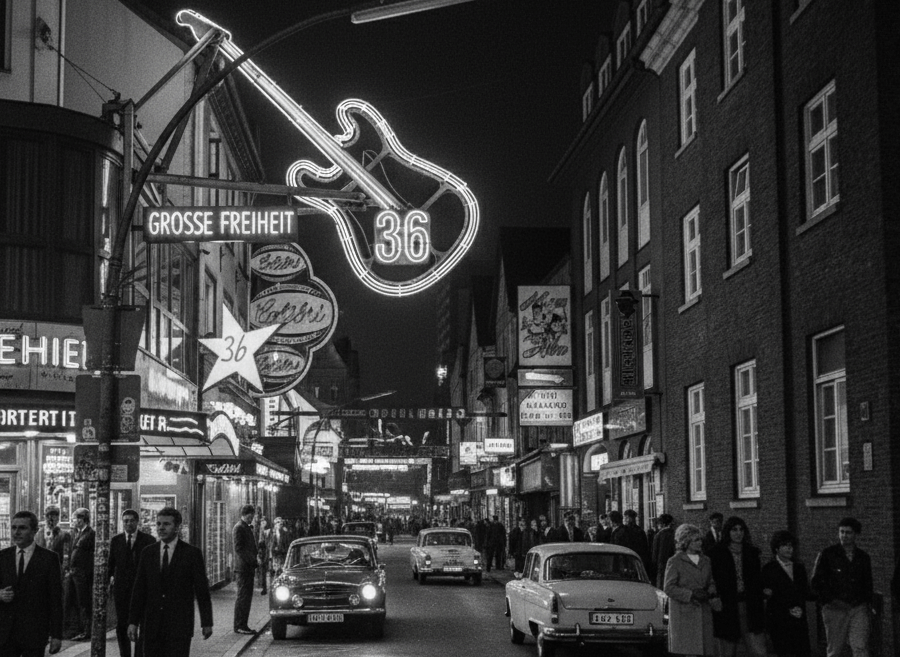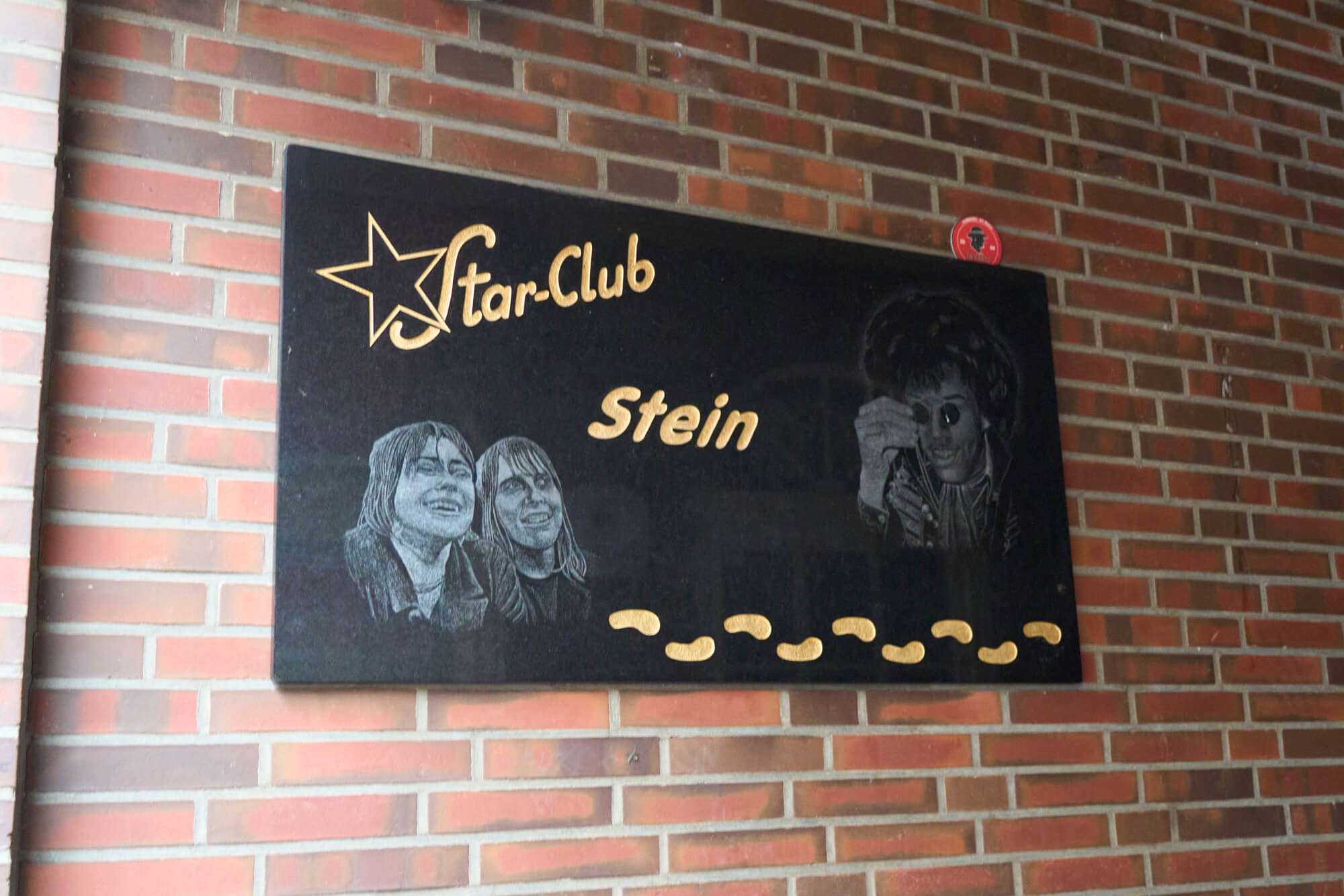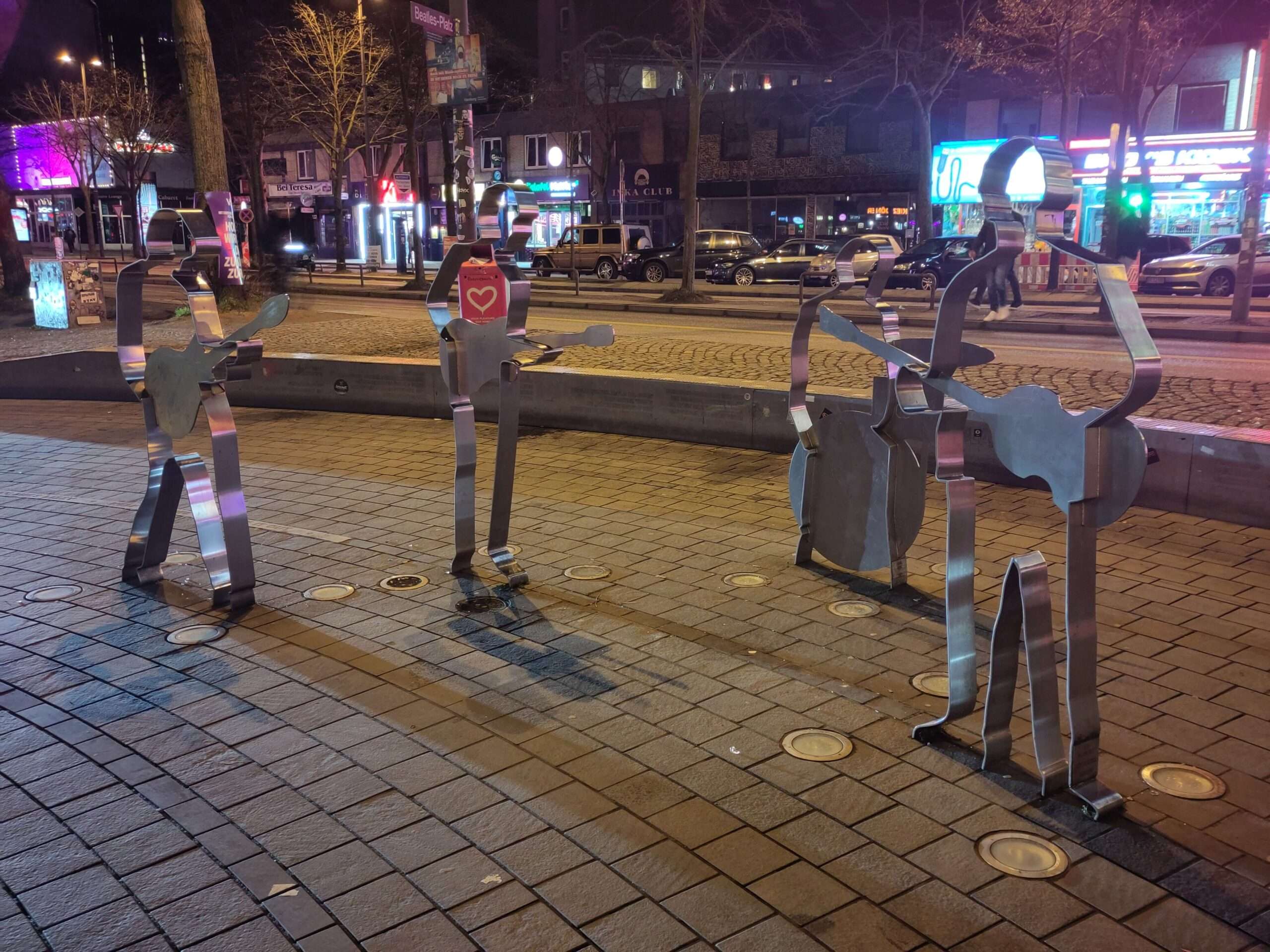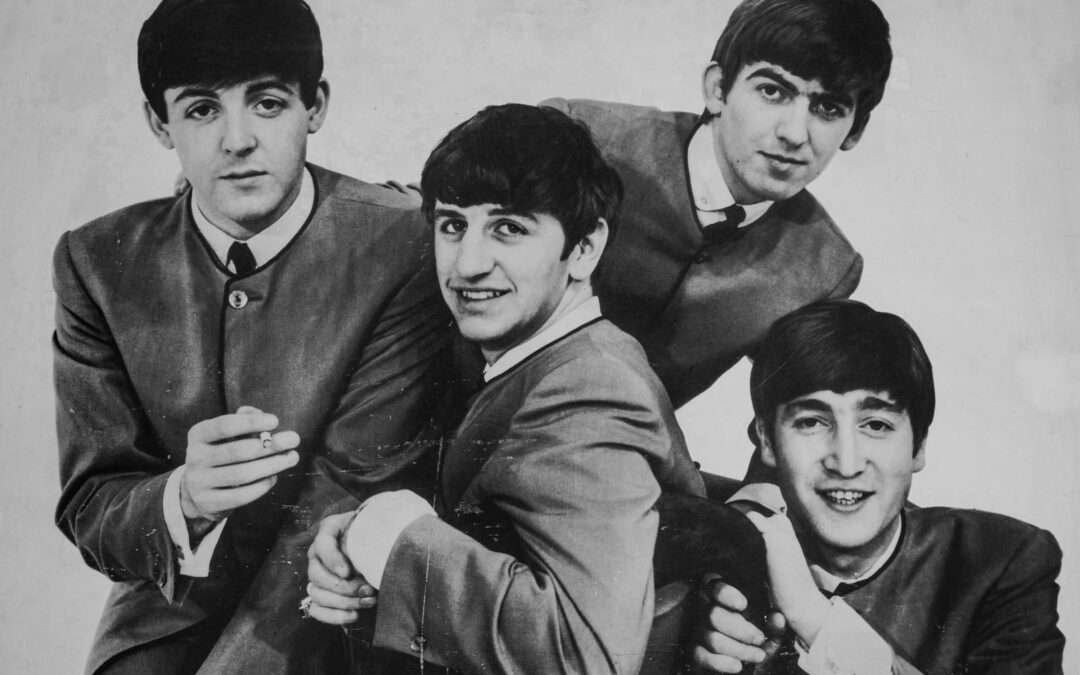“I might have been born in Liverpool, but I grew up in Hamburg”
Imagine walking down the Reeperbahn in 1960: neon signs flicker, sailors on shore leave spill from the bars, the air smells of beer and cigarette smoke, and music pours out of basement clubs into the night. In that noisy, anything-could-happen atmosphere a ragged band from Liverpool arrived, still rough around the edges and hungry for work.
Hamburg didn’t simply host The Beatles… it made them. The long shifts on cramped stages, the demanding, often drunken audiences, and the city’s eclectic musical traffic forced the group to tighten their playing, expand their repertoire, and develop a tougher stage presence. Those years in St. Pauli, playing in tiny cellars like the Indra Club, the larger Kaiserkeller, and later the Star-Club, shaped their sound, sharpened their showmanship, and influenced their look: what many historians and fans now call the “Hamburg Sound.”
Why Hamburg? The city combined three things a young band needed: a wild, round-the-clock nightlife full of paying audiences; a relentless gig schedule that turned raw players into a disciplined live unit; and a melting pot of musical influences like American rock ’n’ roll and R&B records, local performers, and an international port culture, all of which gave the Beatles both material to play and reasons to stand out.
As George Harrison later reflected, “The whole area was full of transvestites and prostitutes and gangsters, but I couldn’t say that they were the audience… Hamburg was really like our apprenticeship, learning how to play in front of people.” This was no ordinary gig; it was a baptism by fire, a place where only the most resilient and talented could survive and thrive. The Beatles didn’t just play for applause; they played for their lives, in a violent, raw and aggressive atmosphere, forging the sound and stage presence that would one day conquer the world. St. Pauli’s gritty charm and relentless demand for entertainment shaped them, turning five young men from Liverpool into the legendary band we know today.
The Arrival: From Liverpool to St. Pauli

In August 1960, five young men from Liverpool – John Lennon, Paul McCartney, George Harrison, Stuart Sutcliffe, and Pete Best – packed their instruments and set off for Germany. The group, who had briefly performed as “The Silver Beatles”, were booked for a residency in Hamburg through their first manager, Allan Williams, who had connections with local club owner Bruno Koschmider.
Koschmider ran several venues in Hamburg’s red-light district of St. Pauli, including the Indra Club and the Kaiserkeller in the Große Freiheit, a side street off the famous Reeperbahn. In the late 1950s and early 1960s, this area was a chaotic blend of music, neon lights, bars, and brothels, crowded with sailors and travellers from around the world. For young rock bands from Britain, it was one of the few places in Europe where they could play rock’n’roll every night and get paid for it.
Hamburg’s music scene in the early 1960s was unlike anything in Britain at the time. In St. Pauli’s small, smoky clubs, live music didn’t stop until sunrise. For The Beatles, this was both a challenge and a crash course in endurance.
They arrived in Hamburg after a long and disorganised van journey from Liverpool, complete with wrong turns and ferry mix-ups, a trip that reflected both their youthful enthusiasm and inexperience. When they finally arrived, they discovered they would be performing six to seven nights a week, often for eight or more hours each night.
Indra Club – The Beginning
Their first stop, the Indra Club in the Große Freiheit 64, was a small and rough venue where they played to noisy, often half-drunk audiences. Many times the audience would throw their beer bottles at the Beatles and it was the bouncer’s job to catch them before they hit the band. But club owner Bruno Koschmider demanded constant energy from his performers, shouting his famous phrase “Mach Schau!” (“Put on a show!”). By the end of their Indra residency, the young Liverpudlians had developed a louder, tighter sound that stood out from other acts on the Reeperbahn.
At first they slept in a cramped, windowless back room behind the screen of the Bambi Kino, a seedy cinema just around the corner from the Indra Club. The space was barely more than a storage closet, furnished with rickety bunk beds that groaned under their weight and walls so bare and unfinished it was as if the landlord had forgotten to finish building them. There was no heating, so the bitter Hamburg cold seeped through the cracks, and the only light came from a single bulb dangling precariously from the ceiling. Showers were a luxury they couldn’t afford; instead, they washed up in the cinema’s public restrooms, splashing water on their faces in sinks meant for patrons who had just watched the latest films. To make matters worse, their makeshift dormitory was situated right next to the women’s toilet, a detail that left them feeling like they were, as they famously quipped, “sleeping in a toilet.” The stench of stale cigarettes and disinfectant lingered in the air, and the thin walls did little to muffle the sounds of the cinema’s late-night crowd or the occasional drunken brawl spilling in from the street. The constant dampness made everything feel clammy to the touch. It was a far cry from the comforts of Liverpool, but these squalid conditions became part of the Beatles’ origin story, a brutal initiation into the life of a working band. Hungry, exhausted, and often broke, they endured it all, fueled by youthful determination and the unshakable belief that this was the price of their dreams. In that grim little room, among the chaos and the cold, the band bonded in ways they never could have back home.
After several weeks, Koschmider moved them to his larger venue, the Kaiserkeller, where they shared the stage with Rory Storm and the Hurricanes, whose drummer was Ringo Starr. The crowd was tougher, the stage louder, and the hours even longer. But the competition with other British rock groups made The Beatles push themselves even harder. The young Beatles quickly earned a reputation for their energetic performances and tight sound, honed through sheer repetition and long nights on stage. Here they eventually replaced Pete Best, the first drummer, with Ringo Star, giving the band their signature rock beat.
The St. Pauli nightlife was wild and unpredictable, full of sailors, club owners, sex workers, and restless youth. The band learned to adapt fast, reading audiences and surviving in a city that demanded both stamina and attitude. It was in this chaotic environment that The Beatles grew from an amateur group into a professional live act capable of commanding any stage.
In April 1961, The Beatles left Koschmider’s management and began performing at the Top Ten Club, managed by Peter Eckhorn. This change marked a turning point: better pay, improved conditions and equipment, and more musical freedom. It was during this period that they began backing British singer Tony Sheridan, resulting in their first professional recordings, including “My Bonnie”. These sessions, produced by Bert Kaempfert and released on the Polydor label, gave them their first taste of the recording industry.

The Friends, The Chaos, and The Stories That Shaped The Beatles
Hamburg wasn’t just a city where The Beatles played, it was where they found a second family, a circle of friends and characters who shaped their sound, their style, and even their sense of humor. One of the most influential figures in their early days was Astrid Kirchherr, the striking photographer and girlfriend of Stuart Sutcliffe, the band’s original bassist. Astrid’s artistic eye captured some of the most iconic early images of the Beatles, her black-and-white portraits giving the world its first glimpse of the raw energy and charisma that would soon define them. But her influence went beyond photography: it was Astrid who led the band to a tiny barbershop on the Davidstraße, Salon Harry, where they traded their greaser pompadours for the now-legendary “mop-top” haircuts, a look that would become synonymous with the Fab Four. Her connection to the band was deep, especially with Stuart, whose decision to leave music for art in 1961 marked a turning point in the Beatles’ evolution.
Then there was Gerry Marsden, lead singer of Gerry and the Pacemakers, who shared the stage and plenty of wild nights with The Beatles. One infamous story involves Gerry and John Lennon venturing into the notorious Herbertstraße, Hamburg’s red-light district, for John’s first (and last) encounter with a prostitute. As Gerry later recounted, they negotiated a price with a pimp, only for the woman to arrive—half-dressed and, in Gerry’s words, “the size of a bus.” Panicked, both bolted from the brothel without a second thought, leaving their money behind and never daring to return.
No tale of the Beatles in Hamburg would be complete without Horst Fascher, the burly bouncer at the Indra Club who later became the manager of the Star-Club. Horst was the kind of no-nonsense protector the band needed in the rough-and-tumble world of St. Pauli. His memoirs are filled with original stories, including the time he caught John Lennon in a tête-à-tête with a female fan just before a show in the restroom. To snap John out of his distraction, Horst dumped a bucket of ice-cold water over him. The result? John stormed onstage dripping wet, wearing nothing but his underwear and a toilet seat around his neck and played the entire set that way. (Want the full story? Come along on one of our tours!)
There were others, too: Klaus Voormann, a young artist and bassist who became a lifelong friend, designing the cover for Revolver and playing on solo records for John, Paul, and George. And let’s not forget Jürgen Vollmer, a photographer and friend who helped shape their image, or Tony Sheridan, the musician they backed on their first professional recordings. These friendships were more than just footnotes, they were the foundation of the Beatles’ Hamburg chapter, a time of chaos, creativity, and camaraderie that would follow them long after they left the Reeperbahn. The city’s gritty charm and the people they met there didn’t just influence their music; they helped turn five scrappy lads from Liverpool into the band that changed the world.
Star-Club – The Peak of the Hamburg Years

When the Star-Club opened in April 1962, it quickly became Hamburg’s premier rock’n’roll venue, hosting international acts like Little Richard, Jerry Lee Lewis, and Gene Vincent. The Beatles returned for several engagements between April and December 1962, already on the verge of fame in Britain.
Their performances at the Star-Club were later described by witnesses as electric: confident, polished, and far more professional than when they had first arrived in 1960. In many ways, this was the culmination of their Hamburg apprenticeship. By the time they left Hamburg for good, The Beatles had logged more than 250 nights of live performance and over 1,200 hours on stage in just over two years. These relentless shows didn’t just make them better musicians; they transformed them into one of the tightest live bands in Europe.
The Sound of Hamburg
During their Hamburg residencies between 1960 and 1962, The Beatles’ music evolved at lightning speed. Surrounded by American rock’n’roll, rhythm & blues, and local skiffle and jazz, they expanded their repertoire from simple covers to complex harmonies and tight arrangements. They learned to perform as a unit: loud, raw, and confident.
But not all of The Beatles’ Hamburg adventures were on stage. In November 1960, German authorities discovered that George Harrison was only 17 years old and therefore too young to perform legally in the clubs. He was promptly deported back to England.
Soon after, Paul McCartney and Pete Best were arrested after a small fire broke out in their Bambi Kino room. The result of burning a condom and former contract from Bruno Koshmider as a prank after tensions with him. They spent a night at the Davidwache police station before being deported as well. Despite these setbacks, the group returned several times between 1961 and 1962, each time stronger, more disciplined, and more determined.
Many of The Beatles’ earliest hits were shaped in the clubs of Hamburg. Songs like “I Saw Her Standing There,” “Love Me Do,” and “Twist and Shout” were refined through endless live performances long before being recorded. The constant repetition and audience feedback sharpened their sound and timing.
The band also made humorous attempts to connect with their German audiences. Later, in 1964, they even recorded two songs in German: “Komm, Gib Mir Deine Hand” and “Sie Liebt Dich”, a nod to the country that had helped launch their career.

Hamburg’s Enduring Beatles Legacy
The Hamburg years were crucial. The Beatles arrived as a local Liverpool act and left as a professional, internationally seasoned band. And the city never forgot them.
Today, Hamburg still proudly celebrates its place in Beatles history. On the Reeperbahn, the circular Beatles-Platz features life-sized steel silhouettes of the five original members, positioned near the sites where they first played. Visitors can still see the Indra Club, Kaiserkeller, and the Star-Club’s former location, as well as the Davidwache police station and Bambi Kino, where the Beatles’ story truly began.
Liverpool gave The Beatles their roots. Hamburg gave them their wings. Here they learned endurance, stage presence, and the raw discipline that later fuelled their global success. Hamburg’s influence can be heard in their sound and seen in their attitude. The city’s rough energy shaped not only The Beatles, but the entire British Invasion that followed.
You can walk in the Beatles’ footsteps every day with us! Join Robin and the Tourguides on our Harbour & St. Pauli Free Tour, where we bring these wild, wonderful stories to life as we explore the streets that made the Fab Four. Or, if you’re a true Beatles devotee, dive even deeper with a private Beatles Tour, designed for fans who want the full, unfiltered Hamburg experience.
So whether you’re here for the music, the history, or just the sheer joy of standing where legends once played, we’re ready to show you the magic and the mayhem of the Beatles’ time in Hamburg. Visit us at www.robinandthetourguides.de and let the adventure begin.

